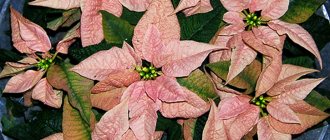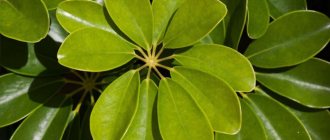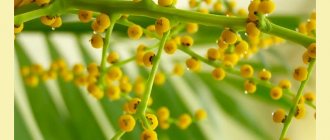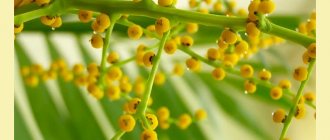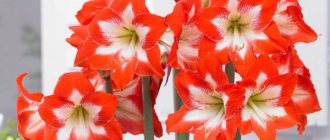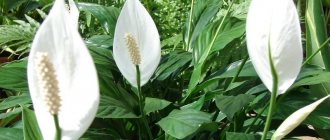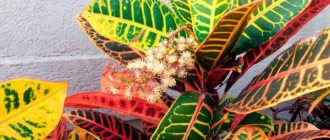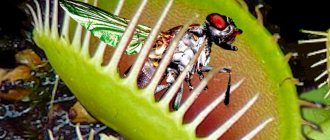If you have a Christmas star flower growing at home, then read the article. It tells you how to care for this plant and how to deal with pests.
On the eve of the New Year and Christmas , a flower boom begins: stores are full of cute pots with different miniature flowers. After all, this is a great holiday gift for lovers of home flowers.
Read an article on our website about why violets do not bloom at home. You will learn the reason and secrets that will help make the flower bloom.
Among the various plants on store windows, the Poinsettia flower, or as it is more often called the Christmas star . More details on how to care for this “miracle” are described in this article. Read on.
Red leaf flower Christmas star: history, legends
Flower "red leaf" Christmas star
The flower "red leaf" Christmas star comes from Mexico, where it grows in tropical thickets in the form of a green shrub that is always green. Its height is about 4 m . His story is very interesting:
- It became known as a potted plant about 100 years ago, thanks to the enterprising gardener Paul Ecke.
- He was the first to grow and sell this flower.
- Paul's work was continued by relatives, and now the American city of Encinitas produces approximately 80% of all poinsettias grown in the world.
- In terms of its profit, this business is approximately comparable to the income received from the sale of bulbs and flowers of Dutch tulips.
Red Leaf Flower Christmas Star
The exotic appearance of the plant has given rise to beautiful legends associated with its origin and cultivation:
- The people of Central America, whose ancestors were the Aztecs and where the plant is also widespread, believe that it was the favorite flower of their leader Montezuma.
- He worshiped his patroness, the goddess, who fell in love with a simple young man.
- But the goddess's heart was broken by this love, and drops of blood fell to the ground and turned into a bush. At its top, not green leaves began to grow, but blood red ones.
- When colonists and missionaries preaching Christianity appeared America Christmas by a girl from a very poor family.
- She bitterly regretted in her heart that, apart from the inconspicuous bouquet that she picked along the road, she had nothing else to bring to the temple for the holiday.
- With these thoughts, the girl lovingly laid her bouquet at the feet of the born Christ .
- After some time, the top of the plant turned bright red, and the whole plant suddenly became unusually beautiful. Since then, Catholic churches have been decorated with these flowers, which look like stars, on the day of the Nativity of Christ .
The flower owes its name to Joel Roberto Poinsetta . He was not only a diplomat, the first American ambassador to Mexico, but also an avid botanist. The young man collected herbariums and made descriptions of the plants of this country, growing in his flower garden the most curious specimens of the flora of Mexico found. The flower, now known throughout the world, was named after him.
What is the name of the Christmas star: Poinsettia flower
Red Leaf Flower Christmas Star
The Christmas Star plant is called Poinsettia . Such bright inflorescences have several other names:
- Latin - Euphorbia pulcherrima.
- Systematic - Beautiful spurge , from the genus Euphorbia , family Euphorbiaceae.
- Christmas star or Star of Bethlehem - the shrub received this name because the flowering period coincides with the Christmas holidays and, in addition, the bracts resemble a star.
- It is also called Holy Night Flower .
- In Chile it is called the Crown of the Andes , and in Spain the Easter Flower .
This is a very interesting flower that can bloom not only with red petals. Read on.
Poinsettia transplant and substrate for it
The Christmas star is transplanted at the end of the dormant period - it occurs at the end of April - beginning of May. The signal for the beginning of growth is the young leaves that appear on the branches.
Important! Poinsettia is replanted by transshipment, that is, while maintaining the same earthen lump.
The plant, together with its native clump, is placed in a new container, 2-3 centimeters in diameter larger than the previous one. A drainage layer must be laid on the bottom.
The most suitable substrate for the Christmas star consists of a mixture of leaf and clay-turf soil mixed with peat and sand (2: 3: 1: 1). The reaction is neutral or, in extreme cases, slightly alkaline.
Home flower Christmas star - how it blooms: photo in autumn, what flowering colors are there?
Home flower Christmas star
What does poinsettia look like - home flower Christmas star ? The photos above and below show what beauty awaits you in autumn and winter if you plant such a plant at home.
Home flower Christmas star
The plant blooms so beautifully. Description:
- This is a small bush no more than 50 cm with dark green leaves with jagged edges and a small petiole.
- The leaf has an elongated ovoid shape, 10-15 cm in length.
- The main decoration is not the flowers, but the bracts, which have the same shape as the leaves, but are slightly smaller in size and very different in color.
- By the time the flowers bloom, they become bright scarlet.
Flower Christmas Star
Nowadays, varieties not only with red leaves have been bred. There is also a flower with foliage of a similar color:
- Pink
Home flower Christmas star
- White
Home flower Christmas star
- Lilac
Home flower Christmas star
- Burgundy
Home flower Christmas star
- Lilac
Home flower Christmas star
- Combining several shades
Home flower Christmas star
The flowers themselves fade into the background when compared with the brightest bracts. They are minimal in size, collected in flower rosettes, and have a nondescript shade of pale yellow.
Home flower Christmas star
Description of poinsettia
Poinsettia (sometimes in Russian-language sources there is a variant spelling with one “t” - poinsettia) is a species of herbaceous or bushy plants belonging to the Euphorbiaceae family and numbering more than 100 representatives.
In Europe, poinsettia is known as “the most beautiful spurge” (Euphorbia pulcherrima - the official name according to the botanical classification), “Christmas” or “Star of Bethlehem”. This is due to the timing of flowering - beautiful bracts bloom just on Catholic Christmas.
In nature, poinsettia looks quite impressive, but “indoor” specimens are significantly smaller
In nature, poinsettia is found exclusively in the tropics. She feels great in the shade of taller trees, preferring mountain slopes. Its habitat is Central America (Mexico, Costa Rica, Guatemala, Belize).
Under natural conditions, poinsettia is a low, graceful shrub 1–3 m high. “Home” poinsettia rarely grows above 0.5 m. The average height of the bush is 30–35 cm. The stems branch intensively, the branches are bare below. The leaves are rich green in color, usually smooth to the touch, in the shape of an elongated ellipse, pointed at the end. The edges are serrated. The average leaf length is 12–15 cm, width is about half that.
Poinsettia leaves surrounding the inflorescences change color
Contrary to popular belief, poinsettia flowers are very inconspicuous. They are very small, yellowish, collected in inflorescences in the shape of an umbrella or rosette. What are considered bright petals - scarlet, crimson, snow-white, combined - are actually bracts. They are densely located on the tops of the shoots. Poinsettia forms buds in mid-December; bracts last until the end of winter.
What is often mistaken for flower petals in poinsettias are actually bracts
Like all Euphorbiaceae, poinsettia stems and leaves contain milky white sap. It is quite caustic and can severely burn sensitive skin, so all work with the plant should be carried out only with rubber gloves. In case of contact with the mucous membrane, there is a risk of severe nausea, vomiting, and stomach pain. Anyone who is allergic to plant pollen should be careful with the flower. Since angioedema and anaphylactic shock can develop.
However, the American aborigines learned to “squeeze lemonade out of lemons.” After certain processing, they use the poisonous juice as an effective antipyretic, a drug for toothache, and a remedy for warts and insect bites. Poultices from the leaves help relieve attacks of rheumatism and radiculitis.
The world owes the popularization of the plant, which was known to the Aztecs under the unpronounceable name cuetlaxochitl (the Indians perceived it as a symbol of beauty), to the first US Ambassador to Mexico, and part-time physician and amateur botanist, Joel Roberts Poinsett (or, in the French manner, Poinsett) . It was in honor of him that the flower received its name.
In Europe and the USA, Christmas without poinsettia is unthinkable, just like without a spruce tree and gifts.
The fashion of giving poinsettias for Christmas at the beginning of the 20th century was introduced by the owner of the greenhouse, Albert Ecke, and consolidated by his son Paul.
Poinsettia is also valued among adherents of the teachings of Feng Shui. It is believed that the flower develops the owner’s sociability, attracts pleasant people to his home, neutralizes the influence of negative energy, “extinguishes” conflicts and quarrels, and relieves stress. The owner of the poinsettia develops leadership qualities, women lose weight effortlessly and look significantly younger than their age. Because of such “violent activity”, it is not recommended to place the flower in the bedroom - it simply will not allow the owner to sleep peacefully.
Video: appearance of the most beautiful poinsettia
Flower Christmas star: choice in store
Flower Christmas Star
If you decide to give your friends or loved ones a gift in the form of a Christmas star the New Year , then at the point of sale you need to be careful and choose a suitable copy. The criteria for choosing a flower are:
- You should immediately pay attention to the poinsettia pots standing on shelves without packaging, and make a choice among them. Packaging can hide flaws and poor quality of the plant.
- The bush should be evenly developed on all sides , individual stems should not stick out and disturb the overall composition. Bare areas of branches should not be visible from under the leaves.
- The leaves are a rich dark green color. If there are wilted, drooping leaves with yellow spots or completely yellowed leaves, it means the plant is depressed and should not be purchased.
- The bracts are completely colored in the color characteristic of the variety. They should not have greenish spots, which indicates that the plant is underdeveloped.
- A careful inspection of the flowers is important - you can touch one of them with your finger. They should not have pollen on them. If it is still present, this indicates that the plant’s growing season will soon end and the bracts will fall off, the plant will very quickly lose its decorative appearance.
- Feel the soil in the pot. It should not be overly moist or, conversely, dry. Both indicate poor flower maintenance. if he ends up at home, he may simply die.
But now the purchase is made. By the way, do not buy a plant on the street, it will immediately wither at home, because... low temperatures will destroy it. Now you need to properly bring the plant home. At temperatures below 15°C, the poinsettia must be covered and in a box or wrapped in a packing paper sheet, otherwise transportation will have a very bad effect on it.
Poinsettia propagation
In nature, poinsettia is propagated by seeds, but at home this method does not bring positive results, so cuttings are used.
For poinsettia propagation, apical cuttings that remain after pruning are quite suitable. In this case, the lower cut is formed obliquely - at an angle of about 45 0. The length of the cuttings is desirable from 7 to 10 centimeters, the number of large buds on them is at least 4.
They are washed in warm water to remove the milky juice, treated with a root formation stimulator and lightly dried in air. The rooting soil is made up of sand, dry manure and humus.
Cuttings are planted in a well-moistened substrate, covered with a transparent film or bag and placed in a bright place, but not in direct sun. The temperature is maintained at 24-28ºС.
Planted cuttings need daily ventilation and watering or spraying with warm, settled water every 3-4 days.
When the cuttings are completely rooted, the film is removed and transferred to a cooler place where the temperature will be 16-18 degrees.
In mid-autumn, approximately from the second decade of September, the cuttings are planted in individual pots with a diameter of 20 centimeters. Next year, if you follow all the rules for caring for poinsettia, the young bushes will bloom.
Christmas star flower: watering rules, how else to care for it at home so that it blooms?
Christmas Star Flower
the Christmas Star flower are simple:
- In summer you need to moisten the soil 2 times. in 7 days , in winter - 1 r. during the week .
- In any case, you need to focus on the condition of the soil in the pot - it should be slightly moist.
- It is forbidden to overfill the soil, because the roots can be affected by various rots.
- It is also dangerous to completely dry out the earthen clod; only light drying of the top layer of soil is allowed.
- The liquid for irrigation should only be used when it is warm and it is advisable that it sits for a day and night.
- It is also necessary to spray the flower with warm water, slightly moistening the air around it.
Read an article on our website about how to properly replant an indoor flower. Learn the tips of the professionals to ensure your flowers always look gorgeous.
How else to care for it at home so that it blooms? Here are the tips:
- For good flowering, it is important to provide the plant with sufficient lighting.
- But direct burning rays of the sun should not fall on the bush.
- Poinsettia also responds positively to temperature conditions, which during flowering should be no higher than 16°C .
Read on to learn what else you need to do to ensure beautiful flowering.
Water regime in the plant’s homeland
The homeland of poinsettia is Mexico, whose climate is formed by the mountains and the surrounding water expanses of the Pacific Ocean and the Caribbean Sea. The Christmas Star's natural habitats are in tropical deciduous forests along the coast.
The country experiences a rainy season from May to October, bringing huge amounts of precipitation. Uneven irrigation throughout the year has made adjustments to the water regime of the plant. During the rainy season, poinsettia is saturated with moisture for future use .
Next comes a period of active flowering, after which the plant goes into a dormant state.
Important! Plant budding and budding require significant water resources.
How to trim a Christmas star flower?
Flower Christmas Star
To make poinsettia bloom repeatedly, you need to prune the flowering bush. Flowering in this bush occurs only on young shoots. How to trim a Christmas star flower ?
- This process begins after the bush has bloomed and almost all the leaves have flown off.
- Before pruning, you need to dry the earthen ball well, but not until completely dry.
- Now on each stem, find the first bud from the ground. It will be located approximately in the place where the already fallen leaf grew. The bud is very small, but you can still notice it.
- Using sharp pruning shears, carefully cut the stem about 0.5 cm above this bud.
- Juice will immediately appear on the cut, so work must be done with gloves.
After pruning, water the soil in the pot.
Poinsettia pruning
After flowering (the inflorescences have fallen off), you need to cut the stem to 1/3 of its length. If you want to rejuvenate your already mature plant, then cut more stems, leaving 7 cm above the soil. At each cut point, the plant will produce new stems. For beautiful flowering you need to leave 4-5 good branches on the plant. You can select them when they reach 10 cm.
Indoor flower Christmas star: rules of propagation, transplantation
Indoor flower Christmas star
If necessary, poinsettia can be propagated. But this is not so easy to do. You need certain skills and experience working with this plant. Here are the transplant rules:
- The Christmas star indoor flower is propagated by cuttings that grow after pruning.
- They should be at least 9-10 cm , well developed and without signs of disease.
- You need to cut the cutting under the node that connects the cutting and the stem.
- Now place the cutting in a vase with warm liquid for a few minutes to allow the juice to come out.
- Prepare a pot in advance with loose soil soaked in special fertilizers.
- Treat the cut of the cutting with Kornevin or some other root growth stimulator.
- After making a hole, immerse the cutting about one-third into the soil. Pour it thoroughly.
Rooting will occur within 20-30 days.
Poinsettia propagation:
Propagated by cuttings obtained during the formation and pruning of the plant in spring and summer. Cuttings must have at least 4 interstices. After receiving the cuttings, they are placed in water to drain the milky juice, and then the cut is dried. Root in the soil at a temperature of 24-28°C, having previously treated the cuttings with root, under a greenhouse, where constant humidity is maintained. On average, rooting takes place within 3 weeks. After rooting, the plant must be pruned in order to stimulate branching.
Pests of Poinsettia: Damaged by spider mites, thrips, mealybugs.
Poinsettia Burgundy.
Christmas star - flower after flowering: care rules
Christmas star - flower after flowering
Usually the Christmas star is presented as a New Year's . A few weeks will pass and the plant will shed its leaves, the stems will become bare and it seems as if it has died. But that's not true. Poinsettia is going into dormancy. If after flowering you provide it with proper care and maintenance, then the next year, in winter, it will bloom again and become decorative. What needs to be done for this? Here are the rules of care:
Christmas star - flower after blooming
- Reduce watering to a minimum; the soil in the pot should be almost dry, especially since there is no need to fertilize.
- Trim the stems so that they are no more than 15 cm from the soil level in the pot, as in the picture above.
- Place the bush in a cool and dark place where the temperature is within +13-14°C . Typically this location can be found under the bathroom or in a closet. If you have a cellar, you can place it on the lower rack, where the coolest place is. The flower will remain here until May.
- When spring comes, place the poinsettia pot on a sunny windowsill, but so that direct sunlight does not fall on the container and bush.
- Watering and feeding are resumed. Add liquid 2 r. in 7 days , but do not overfill the water, the soil should be slightly moist.
- Feed no more than 1 day. in 20 days complex min. fertilizer for flowers.
As soon as the growth of young buds and stems begins, do the following:
- Replant the poinsettia in fresh soil . To do this, choose a pot that is slightly larger than the old one. Soil can be bought at the store. It can be specialized - with a set of microelements necessary for the plant, or universal. In any case, you need a crumbly, breathable, neutral pH .
- Carefully remove the plant from the old pot.
- Remove the top and gently shake the soil from the lower roots.
- Then you need to place it in a new vessel with half-filled earth. At the same time, make sure that the roots do not bend or intertwine.
- Now carefully fill the pot to the top . You need to make sure that the root collar is at the same level as the old pot. All that remains is to spill the entire soil with warm liquid.
Poinsettia must increase its vegetative mass. Growth will continue until the end of October. Now create excellent conditions for it so that the bush blooms well. To achieve this, daylight hours are reduced to 10 hours . This can be done by covering the pot with a large box so that light does not penetrate inside. Continue to do this until the bracts begin to open. After this, proceed to normal care.
There is another interesting home flower - Dracaena Palm . Read about its care, it’s simple, and grow it at home. This plant is also called the tree of happiness.
Caring for poinsettia at home
It is recommended to grow beautiful euphorbia on windows of eastern or western orientation. It should be borne in mind that such a flower reacts extremely negatively to drafts and direct sunlight. During active growth of the bush, the temperature in the room should be from 18 to 25 degrees, during the flowering period - from 14 to 16 degrees, and during dormancy - from 12 to 14 degrees.
In summer, the bushes need to be watered systematically and abundantly. At the same time, in winter, watering should be reduced, the substrate should be only slightly damp. After the bush begins to bloom, it must be moistened with lukewarm water from a sprayer.
Top dressing
Feeding such a plant must be carried out in spring, autumn and summer once every half month; for this purpose, complex mineral fertilizer is used. When the bush blooms, it will need fertilizers with a high potassium content. But most gardeners are superstitious and do not feed poinsettias during flowering.
Transfer
Transplantation is carried out in the spring, usually in April–May. This is done at the end of the dormant period after young foliage appears on the bush. For planting, you need to use a slightly acidic substrate, which includes clay-turf, leaf and turf soil, as well as sand in a ratio of 3:2:1:1. It is necessary to make a drainage layer at the bottom of the pot. When transplanting, the new pot should be slightly larger than the old one. In order for the bushes to suffer as little as possible during transplantation, you should resort to the transshipment method.
Poinsettia pruning
Pruning beautiful milkweed is not difficult. This procedure is carried out 2 times a year: in the first days of April during the dormant period, while the bush is shortened to 15 centimeters from the substrate level, and also after transplantation, when young shoots begin to grow on the bush. Thanks to pruning, it will be possible to form a spectacular bush, while cutting out all the weak stems; if desired, they can be used as cuttings for vegetative propagation.
How to prune poinsettia
Poinsettia propagation
Under natural conditions, such spurge reproduces by generative (seed) method. When grown indoors, the cutting method is used to propagate such a plant. The cuttings should be harvested in the first weeks of summer; they should reach 70–100 mm in length, and they should have at least 3–6 good buds. The cut should be made directly under the node. The cut-side-down sections should be immersed in lukewarm water, where they should remain for several minutes, thanks to which the poisonous juice can escape from the cutting. After this, the cut sites are treated with a solution of a product that activates root growth. After this, they are planted in containers filled with moistened soil mixture, which should include dry manure, sand and humus. The container is placed in a well-lit, warm place (from 24 to 28 degrees) without bright sunlight, and the container must first be covered with film. Do not forget to periodically spray and ventilate the cuttings.
After about 4 weeks, the cuttings should be completely rooted and can be moved to a cooler location, but it should not be colder than 16 degrees. In autumn, young plants should be planted in pots measuring 18 to 20 centimeters in diameter; only after a year the bushes will become very beautiful and begin to bloom.
Diseases and pests
Pests
In some cases, harmful insects such as thrips, scale insects, whiteflies, mealybugs and spider mites can settle on the bush. Mealybugs can secrete a white, waxy substance, while whiteflies and aphids leave sticky spots on the surface of the foliage. To destroy them, you can resort to traditional methods or treat the bush with a systemic insecticidal preparation. In order to get rid of scale insects and aphids, the foliage must be wiped every day on both sides with a soap solution, and then it must be rinsed in the shower. In order to destroy scale insects, the foliage is treated with mineral oil. However, most often, to destroy pests, you have to resort to the use of chemicals.
Diseases
Such a plant can become ill with fusarium, gray mold or powdery mildew. The development of gray rot is promoted by increased air humidity, while a gray coating of mold appears on the inflorescences, stems and shoots, and brown spots form on the foliage. Affected bushes must be treated with Skor, Fundazol or Celandine.
Due to fusarium, the stems first become brown and then almost black, after which they wither and die. In bushes affected by powdery mildew, a white coating appears on the flowers and foliage, and as the disease develops, the bush underneath gradually turns brown. To get rid of such fungal diseases, you need to use fungicidal preparations, for example, Topaz, Celandine, Fitosporin-M or Skor.
Possible problems
Why do poinsettia leaves turn yellow?
If the bushes are kept in a cool room and water regularly stagnates in the substrate, rot appears on the root system and the foliage turns yellow.
Also, the foliage may turn yellow if the air humidity in the room is extremely low. Because of this, spider mites settle on the bush, which causes a change in the color of the leaf plates.
Why do poinsettia leaves fall off?
Foliage may fly away due to excessively low air humidity in the room or due to stagnation of water in the substrate in a cool room. At first, the leaf blades turn yellow, and then fly off. Yellowing and flying of leaves is also observed with excessively poor watering.
After the Christmas holidays are over, the leaf blades on the bushes will turn yellow and fly off. This is how the plant prepares for the dormant period.
In some cases, foliage may fly away due to poor lighting or sudden changes in temperature.
Why doesn't poinsettia bloom?
Most often this happens due to the fact that the agrotechnical rules for growing this crop were violated. To avoid such mistakes, you need to carefully study the section on the flowering of the most beautiful milkweed. In order for the bush to bloom accurately, it is necessary to ensure the correct temperature and light conditions.
Poinsettia after flowering
The dormant period of poinsettia begins in March or April, and it lasts approximately 1.5 months. After the bushes begin to lose their leaves, their stems need to be shortened to 15 centimeters from the surface of the substrate. Then the pot is transferred to a cool and dark place. The plant should rest well and only occasionally be watered with a small amount of water. In May, the dormant period will end, and the flower will need to be cared for in the same way as usual.
How to Grow Poinsettia Christmas Star
The red flower Christmas star is withering in the house: what to do?
Red flower Christmas star withers in the house It is
always unpleasant when house plants die. It happens that the red Christmas star in the house withers. What to do? This can happen for various reasons:
- First, check the soil to see if it is waterlogged.
- Perhaps the plant does not have enough light - move it to the brightest part of the windowsill.
- If the ambient air temperature is less than 18°C , then this can also cause leaves to fall. Move the container with the bush to a warmer windowsill.
- Poinsettia does not tolerate sudden changes in temperature and air humidity very well, so there is no need to open a window for ventilation if there is a flower near it.
Dry air is also not the best option for growing such a plant. As mentioned above, it must be periodically irrigated with warm liquid, while not forgetting to humidify the surrounding air.
How to care immediately after planting?
The main thing is to carefully monitor the humidity level. The soil should not become crusty; overflowing is unacceptable . During the growing season, fertilizer is applied with mineral complexes at least 2 times a month.
Important! The plant drops all its leaves after flowering.
Poinsettia is considered a Christmas flower, and many gardeners try to time the plant's flowering to coincide with the winter holidays. For this purpose, at the end of September, a “night effect” is artificially created for it. Over the course of 2 weeks, the bush is covered with thick fabric for almost the whole day. Thanks to the shortening of the sunny day, the flowering process will occur just in time for the required period.
Christmas star flower: diseases and pests
Christmas star flower: diseases and pests
Poinsettia, like many house plants, is susceptible to diseases. The Christmas star flower and pests can affect it.
- Leaf blades may develop powdery mildew . This occurs at low temperatures and constant and heavy watering. Just in case, for prevention, treat the leaves with phytosporin several times during the growing season.
- Gray rot and fusarium wilt constantly affects the plant. The preventive measures are the same.
- Overwatering the plant too often can cause various root rots. You can fight them with the same phytosporin or another biological product, for example, trichodermin.
There are also a lot of pests. The spider mite is especially dangerous - the enemy of all indoor flowers. It loves dry air, so moisten the space around the flower and the leaves themselves more often with a spray bottle. Thrips, scale insects and whiteflies can attack poinsettias while the green leaves are growing. They are destroyed using special insecticides, which are easy to purchase at any flower shop.
Poinsettia pests, diseases and treatment
Important! For most indoor plants, and poinsettia is no exception, improper care and inappropriate living conditions are the main cause of pests and diseases.
Most often, the Christmas star is attacked by whiteflies, scale insects, spider mites and mealybugs.
The best household insecticides that help remove insects are a solution of soap - laundry, pine, tar or special insecticidal, infusions of shag or tobacco crumbs, garlic or onions, as well as vodka or alcohol.
In severe cases, when home remedies do not help, you have to resort to chemicals - Actellik, Fitoverm, etc. Plants are treated at least 3-4 times with 6-7 day intervals to destroy not only adults, but also larvae.
Of the diseases, poinsettia is most susceptible to gray rot, fusarium and powdery rot.
Gray rot appears as a result of excessive watering. A gray coating and brown spots appear on the leaves and branches. For treatment I use the drugs Fundazol, Celandine and other antifungal drugs.
Powdery rot manifests itself as a white or light gray coating and quite quickly brings the plant to death. The best means of control is Fitosporin-M or Topaz.
Fusarium (root rot) first causes the shoots to die, and then the entire plant dies. To combat it, the roots of the plant are freed from the soil, thoroughly washed with a solution of potassium permanganate, and the affected roots and branches are removed. Then the poinsettia is replanted in a disinfected container with fresh substrate.
Why the Christmas star flower does not turn red: reasons
The Christmas star flower does not turn red
. It happens that the leaves of this plant are always green. It is clear that this is not the norm. Why doesn't the Christmas star flower turn red? Here are the reasons:
- Poor plant care. Provide all the necessary growth conditions, and it will reward you with its colorful flowering.
- The most important factors are the temperature and humidity of the soil and air - this has already been mentioned above.
- Keeping daylight hours is also very important when growing.
Tip: Do not move the pot from place to place unless absolutely necessary. This causes severe stress to the plant, which also negatively affects it.
Christmas star - signs: why do the leaves of a flower turn yellow and fall off?
Christmas star - the leaves turn yellow
The Christmas star is a magical and even enchanting flower. It can improve relationships between relatives and reconcile if they are in a quarrel, remove spells and improve health. It is believed that:
- Euphorbia can be placed near the newlyweds’ bed after the wedding celebration.
- This will speed up the birth of the baby, and the newlyweds will never experience infidelity.
- At other times, it is better to keep the bush in the living room or other room where no one sleeps.
Worth knowing: Poinsettia juice is saturated with poison, so place the container with the plant away from children and animals in the living area.
Here are the signs why the leaves of a flower turn yellow and fall off, although it should bloom vigorously:
- If the leaves suddenly turn yellow or fall off, this indicates the presence of damage or the evil eye in one of the household members.
- The Christmas star is usually a decoration for the New Year's holiday. It is believed that such a wildly blooming flower has the power of healing and brings success.
- Young couples who are unsuccessfully trying to conceive a baby should purchase a young bush. If it blooms, they will have a newborn.
- Sharp yellowing, falling leaves, wilting of inflorescences and red bracts indicate problems with the well-being of family members.
The plant tries to alleviate the sick person’s condition, expending a lot of energy, and may die. There are even more signs below. Read on.
Flower “Home Christmas Star” - signs for the home: impact on energy, health
Flower “Home Christmas Star”
Like any living creature, the flower “Home Christmas Star” subtly senses the atmosphere in the house where it lives. Here are the signs for the home and the impact on energy and health:
- A good, beautiful bush with elastic dark green leaves indicates that everything is fine in the house, the home energy is positively charged. Luck and prosperity will not leave this house.
- But, if suddenly the owners notice that not entirely positive changes are happening to the flower, although it receives everything it needs for normal growth, then something wrong has happened in the family. Quarrels, insults - all this negatively affects the flower. Try to find out if anyone at home is hiding their dissatisfaction or troubles at work.
- It is quite possible that someone in the family has health problems. Then the Christmas star will look depressed, trying to take on the negativity. She spends a lot of her vitality and may even die.
- The plant signals to the owners that someone is trying to bring damage or the evil eye to the house. This is indicated by a sharp change in the color of the leaves and their subsequent rapid falling.
As mentioned above, there were cases when the plant helped couples who, for some reason, could not have children. Such families gained prosperity, the husband got rid of jealousy once and for all, and the wife got the opportunity to give birth to a child.
The Christmas star flower is very beautiful. When he appears in the house, the energy and atmosphere in it immediately changes for the better. Therefore, if you don’t know what to give to your friends or family for the New Year holidays, then buy a poinsettia and surprise your family. Good luck!
